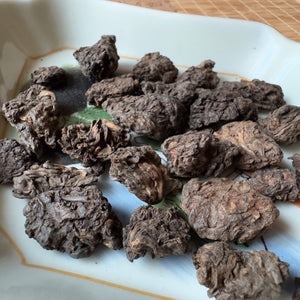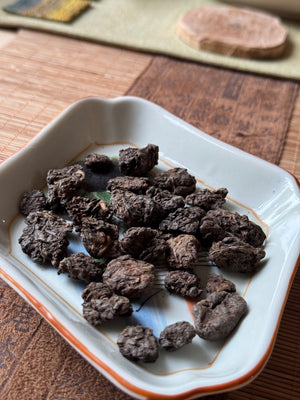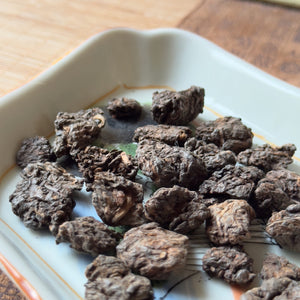
Lao cha tou
Tax included
Shipping calculated at checkout
In stock
Pickup currently unavailable
Lao Cha Tou (老茶头) – shou puer “old tea buds”
Lao cha tou is a denser tea lump that naturally forms during the wo dui (wet heap fermentation) process of making shou puer (post-ripened tea). The pectins and sugars in the leaves bind the pieces together during heat, moisture, and stirring; the master later hand-picks these “nuggets” from the finished batch. The result is a distinct batch: thicker, creamier, usually sweeter, and very long-lasting, with many pours.
Origin & raw material: Yunnan, China • larger leaf Camellia sinensis var. assamica • shou puer processing, naturally formed lumps (not pressed “mini tuo”).
Taste and aroma profile: natural sweetness, dates and dried fruit, caramel, cocoa powder, slight woody-camphor coolness; thick, silky body and a clean, long sweet aftertaste. The buds open more slowly, so the tea remains stable and round even in the “long game”.
Why it's so lovable? Extremely "forgiving" (hard to bitter), ideal for travel and thermos; gives a large yield, excellent value for money. Friendly for beginners, deeply soothing for advanced, a "comfort tea".
Preparation suggestions
Asian (gongfu) method: 6–7 g / 100–120 ml gaiwan or small pot, 98–100 °C water. Short “wake-up”: rinse 5–10 sec, then 1st infusion 20–30 sec (to open the knots), then gradually increase from 10–15 sec. 10+ infusions easily. Tip: if the knots are very dense, the first two can be longer (30–40 sec), or “steam” the leaves in a preheated pot for 1–2 minutes with the lid on before steeping.
Western method: 4–5 g / 300–350 ml, 95–98 °C, 3–4 minutes. ±30 seconds to taste. Can be re-soaked 1–2 times, body and sweetness are well preserved.
Cold brew: 8–10 g / 1 l filtered water, 10–12 hours in the refrigerator. Result: silky, low tannin, chocolate-caramel sweetness. Shake gently before drinking for creaminess.
Useful tips
Opening: Larger lumps can be gently broken in half by hand or with a tea pick for quicker opening. Water: Low mineral water gives the cleanest profile. Purity: A short rinse is usually good for shou puers. Storage: Store in a dry, odorless place, away from light – sweetness and body may continue to develop in the medium term (6–18 months).
Pairing: roasted seeds, dark chocolate, date cakes; excellent "after meal" tea on cool days.

Personal contact
Our teas don't come from wholesale warehouses or unknown sources. We travel to the small producers we source from – whether it's a Japanese family tea garden, a Chinese mountain village or an oolong maker in Taiwan.
Stories
We meet them in person, learn their story, see how they care for their plants, and how they process the fresh leaves.
These experiences are the soul of our teas. This way, not only is the quality guaranteed, but also the fact that behind each cup there is a real person, a real story.
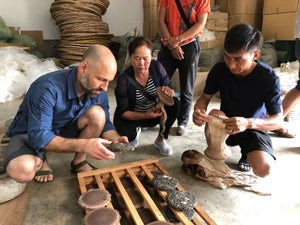

Direct
This direct relationship is valuable to us. Not only because of the excellent tea, but because we believe that trust, respect and personal presence are what make the tea drinking experience truly special.
Teavolution Tea Blog

Oct 2, 2025
Sencha tea
Read more

Sep 21, 2025
Matcha hiány Japánban
Read more
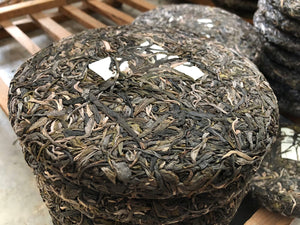
Mar 18, 2025
Puer tea, puerh or pu-erh
Read more
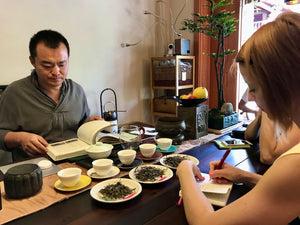
Mar 18, 2025
Types of tea
Read more
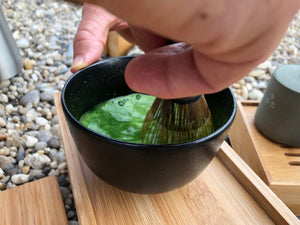
Mar 18, 2025
What is matcha tea?
Read more

Mar 18, 2025
Oolong tea (Wulong tea)
Read more

